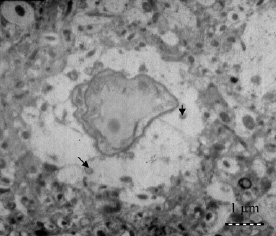| Posted: Mar 13, 2006 | |
Nanocarriers could become an alternative to brain surgery |
|
| (Nanowerk News) If you had brain tumor, would you rather receive your medicine through an injection in the arm or have a hole drilled in your skull? One of the most important applications of nanotechnology could be drug delivery by nanoparticles (or nanoshells) in particular into the brain. An international group of researchers developed a novel targeted nanoparticulate drug delivery system for the brain. | |
| The lead author of the study, Patrick Couvreur, director of the Center for Pharamceutical Studies at the Université Paris Sud explained to Nanowerk: "The delivery of peptides into the brain is a challenge that is not adressed with classical pharmaceutical formulations, since the blood brain barrier doesn't allow the easy diffusion of such molecules." | |
| A tight seal of endothelial cells lines the blood vessels in the brain and acts as a barrier to protect its cells. This is known as the blood-brain barrier (BBB). BBB strictly limits transport into the brain through both physical (tight junctions) and metabolic (enzymes) barriers and keeps most substances, such as chemicals and large biomolecules, out of the brain. | |
| The challenge in treating most brain disorders is overcoming the difficulty of delivering therapeutic agents to specific regions of the brain by crossing the BBB. The problem is the BBB does not differentiate what it keeps out. With very few exceptions, only nonionic and low molecular weight molecules soluble in fat clear the BBB. For instance, alcohol, caffeine, nicotine and antidepressants meet these criteria. However, large molecules needed to deliver drugs cannot cross it. | |
| The development of carrier nanoparticles, as done by this research group, is therefore an important step towards detection and therapeutic treatment of diseases in the brain. BBB investigation is an ever growing and dynamic field studied by pharmacologists, neuroscientists, pathologists, physiologists, and clinical practitioners. | |
| "The chitosan-based immuno-nanoparticles we have developed" says Couvreur "allow transport across the BBB by combining two factors: 1) the ability of cationic (with a full positive charge) chitosan to interact with the negative charges of the brain endothelium and 2) the affinity of the monoclonal antibody OX26 for the transferrin receptor." | |
 | |
| Transmission electron micrographs showing nanoparticles in the brain interstitium (original magnification 5000); (Reprinted with permission from the ACS) | |
| The researchers hypothized that transferrin receptor (TfR), which is highly concentrated in the BBB, may trigger receptor-mediated transport across the BBB. Transferrin itself is limited as a brain drug transport vector since the transferrin receptors are almost saturated under physiologic conditions. However, the antibodies that bind to TfR have been shown to selectively target BBB endothelium due to the high levels of TfR expressed by these cells. Therefore, these antibodies are potential carriers for the delivery of therapeutic agents to the central nervous systems. In particular, a mouse monoclonal antibody, OX26, with a high abundance of transferrin receptors at the brain microvascular endothelium has been detected and was used in the experiments. | |
| Consequently, the researchers designed chitosan (CS) nanospheres conjugated with poly(ethylene glycol) (PEG) bearing the OX26 monoclonal antibody. The nanoparticles were injected intravenously to mice. The results showed that an important amount of nanoparticles were located in the brain. | |
| These findings, which were also confirmed by electron microscopic examination of the brain tissue, indicate that this novel targeted nanoparticulate drug delivery system was able to translocate into the brain tissue after intravenous administration. | |
| The research paper is titled "Development and Brain Delivery of Chitosan-PEG Nanoparticles Functionalized with the Monoclonal Antibody OX26" and was published in the October 20, 2005 online edition of Bioconjugate Chemistry. | |
 By
Michael
Berger
– Michael is author of three books by the Royal Society of Chemistry:
Nano-Society: Pushing the Boundaries of Technology,
Nanotechnology: The Future is Tiny, and
Nanoengineering: The Skills and Tools Making Technology Invisible
Copyright ©
Nanowerk LLC
By
Michael
Berger
– Michael is author of three books by the Royal Society of Chemistry:
Nano-Society: Pushing the Boundaries of Technology,
Nanotechnology: The Future is Tiny, and
Nanoengineering: The Skills and Tools Making Technology Invisible
Copyright ©
Nanowerk LLC
|
Become a Spotlight guest author! Join our large and growing group of guest contributors. Have you just published a scientific paper or have other exciting developments to share with the nanotechnology community? Here is how to publish on nanowerk.com.
